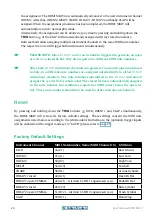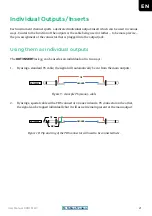
☛
All of the DRM1 MKIV instrument channels sport individual outputs (OUT/
INSERT)
r
, allowing you to patch them into the inputs of a mixing console or
of an audio interface. Find more details in chapter “Individual Outputs/Inserts”
on page 21. Use the stereo output jacks for the first experiments with your new
DRM1 MKIV.
2. Before turning on the unit by pressing its
POWER
button
f
, complete all audio connections
to avoid loudness peaks, thumps, and crackling noises in your audio system. These peaks can
lead to distortion and might even damage converters when connected directly to an audio
interface. For safety reasons, turn down the
MASTER
control
t
of the DRM1 MKIV as well as
the input level controls of the units next in the signal chain while connecting and powering
up the device. After powering up the DRM1 MKIV, the corresponding red
POWER LED
u
on
the front panel will light up.
Setting up MIDI Connections (DIN and USB)
1. Connect your trigger device that is to trigger the instrument sounds of your DRM1 MKIV to
the DRM1 MKIV’s
MIDI IN
socket
s
. Trigger devices can be a suitably equipped groove box, a
hardware sequencer, the MIDI output of a software sequencer (using computer audio or MIDI
interface), or a suitably endowed keyboard controller.
2.
MIDI THRU
s
forwards the MIDI data from the MIDI input of the DRM1 MKIV and allows
daisy-chaining more MIDI devices in series.
3. The
MIDI OUT
s
socket transmits MIDI data generated internally. These are MIDI note-on
commands and velocity data that are derived from external trigger signals, received via the
optional
TRIGGER IN
sockets. No other MIDI data are generated by the DRM1 MKIV itself.
4. Alternatively, you may also use the DRM1 MKIV’s
USB PORT
a
. It receives and transmits
the same MIDI data as the IN/OUT sockets. MIDI sockets and USB port may be used in
parallel. Additionally, the USB port can be used for transferring firmware updates.
You may trigger the instruments of the DRM1 MKIV by external analog trigger signals. These are
received via the optional
TRIGGER IN
sockets
y
at the back of the unit. Please find all related
User Manual DRM1 MKIV
EN
7
Summary of Contents for DRM1 MK4
Page 1: ...USER MANUAL DRM1 MKIV...







































